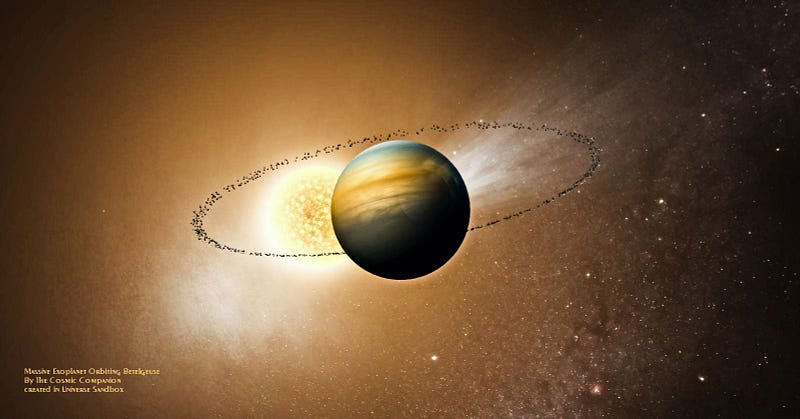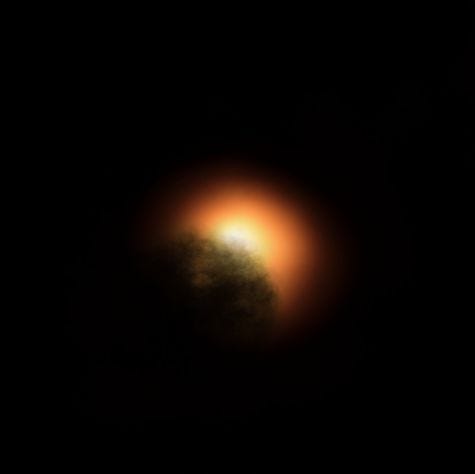Dimming of Betelgeuse: The Mystery Behind Its Recent Fading
Written on
Chapter 1: Understanding Betelgeuse's Dimming
The notable dimming of Betelgeuse observed during late 2019 and early 2020 has recently been decoded, revealing that the red giant star effectively “sneezed.” This unexpected dimming, first recorded in October 2019, saw Betelgeuse lose approximately two-thirds of its brightness by February 2020, leaving both professional and amateur astronomers baffled. Many speculated that this change in luminosity might signal an impending supernova explosion. However, findings from the Hubble Space Telescope (HST) have shed light on this enigma.

An artistic depiction illustrating how material expelled from beneath Betelgeuse's surface likely contributed to its significant dimming observed from Earth. Image credit: NASA/ESA/E. Wheatley (STScI)
In an episode of Astronomy News with The Cosmic Companion airing on August 25, Dr. Andrea Dupree, who spearheaded the study, provides further insights. Betelgeuse, located in the constellation Orion, is among the most recognized stars in the night sky. This aging giant experiences dramatic fluctuations in both size and temperature as it undergoes various thermonuclear reactions and gravitational collapse. If positioned at the heart of our solar system, the outer edge of Betelgeuse would engulf the orbits of all inner planets, extending to Jupiter.
I Take a Dim View of Your Actions, Betelgeuse…

Even at Pluto's distance from the Sun, Betelgeuse would dominate the sky of any celestial body orbiting this red giant. Image credit: The Cosmic Companion/Created in Universe Sandbox.
Hubble's observations indicate that a dust cloud formed through a series of events that obstructed light from Betelgeuse, leading to the dimming witnessed as New Year’s 2020 approached. The star's surface features rising and falling currents that circulate stellar material, which create convection cells. This process resulted in the expulsion of superheated plasma, which surged outward through the star's hot atmosphere to the cooler outer regions. The study reveals that this dust cloud blocked light from about a quarter of Betelgeuse.
Hubble's ultraviolet observations captured heated plasma traversing Betelgeuse’s atmosphere from September to November 2019. In the following month, astronomers noted a striking dimming over the star's southeastern quadrant. "With Hubble, we previously observed hot convection cells on Betelgeuse’s surface, and in the fall of 2019, we detected significant amounts of dense hot gas moving outward through the star's extensive atmosphere. We believe this gas cooled millions of miles away from the star, forming the dust that obscured the southern portion of Betelgeuse as imaged in January and February," explained Andrea Dupree, associate director at the Center for Astrophysics / Harvard & Smithsonian.
As the plasma first erupted from Betelgeuse, it was considerably hotter than the surrounding surface. However, as the material—comprising ionized magnesium—moved away from the star, it cooled and darkened. By April 2020, Betelgeuse had returned to its typical brightness.

An artistic interpretation of a dark cloud obscuring light from a substantial portion of Betelgeuse. Image credit: ESO, ESA/Hubble, M. Kornmesser.
"We observed the impact of a dense, hot region in the star's southeastern part moving outward. This material exhibited luminosity two to four times greater than the star’s usual brightness. Then, about a month later, the southern hemisphere of Betelgeuse noticeably dimmed as the star grew fainter. We suspect that a dark cloud resulted from the outflow detected by Hubble," Dupree elaborated.
Betelgeuse is losing mass at a rate 30 million times greater than our Sun. During this recent “sneeze,” the red giant expelled material twice as quickly from its southern hemisphere than at its typical rate. It's plausible that this material release coincided with Betelgeuse's expansion, part of its regular 420-day cycle.
"All stars lose mass to the interstellar medium, yet the mechanism of this loss remains unclear. Is it a continuous wind, or does it happen in bursts, perhaps akin to what we observed with Betelgeuse? We know that other luminous stars shed material that rapidly transforms into dust, making them appear much fainter. However, in over 150 years, such an event has not been recorded for Betelgeuse. This makes it quite unique," Dupree remarked.
Ultraviolet Light Reveals Dark Secrets
The Hubble Space Telescope, with its ability to observe in ultraviolet wavelengths, provides astronomers with a distinctive instrument to explore the cosmos. As anyone familiar with glowing metals can confirm, materials emit a spectrum of colors as they heat. By analyzing these colors, astronomers can ascertain the temperatures of distant objects. This principle explains the varying colors of stars—red stars are the coolest, followed by stars like our Sun, while blue and white stars are the hottest.
However, similar to our Sun, the temperatures in the atmospheres surrounding stars are considerably higher than those on their surfaces. The peak frequency emitted by this intensely heated material falls within the ultraviolet range of the electromagnetic spectrum, making it ideal for observations by Hubble.
"Hubble's sensitivity to ultraviolet light enabled researchers to investigate the layers above the star’s surface, which exceed 20,000 degrees Fahrenheit and cannot be detected in visible light. These layers are partly heated by turbulent convection cells rising to the surface," reported the Hubble team.
Betelgeuse's eventual fate is to culminate in a supernova explosion. If this were to occur, the blast would be easily observable from Earth. The red giant is situated approximately 725 light years away—sufficiently distant to avoid any harmful repercussions for our planet. Nevertheless, the supernova could manifest as a “daytime star,” potentially lasting for months and casting shadows at night.
Currently, Betelgeuse is obscured by the Sun's glare from our perspective on Earth. It remains out of sight from mid-May to early August due to its close angular position to the Sun. This summer, the STEREO mission has allowed observations of Betelgeuse despite its proximity to the Sun's light.
"While unobservable from Earth, Betelgeuse and its neighboring stars have been imaged from the Solar Terrestrial Relations Observatory spacecraft (STEREO-A), which is approximately 69 degrees behind Earth in its orbit," researchers noted in an article published in The Astronomer’s Telegram.
Observations from the STEREO observatory indicated that Betelgeuse experienced a second, less pronounced dimming between mid-May and mid-July. As the star undergoes expansion again in late August and early September, Dupree will continue her studies using the STEREO observatory, looking for indications of another outburst.
Supernova explosions of massive stars like Betelgeuse are responsible for creating the heavy elements that form the building blocks of planets and life, including carbon in our bodies. Given that light takes 725 years to travel from Betelgeuse to Earth, if it had exploded around the year 1295, we would be witnessing the light from that event now.
James Maynard is the founder and publisher of The Cosmic Companion. A New England native turned desert dweller in Tucson, he resides with his lovely wife, Nicole, and their cat, Max.
Did you enjoy this article? Join us on The Cosmic Companion Network for our podcast, weekly video series, informative newsletter, news briefings on Amazon Alexa, and more!